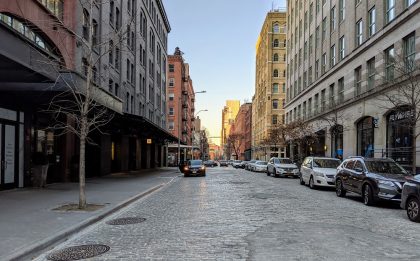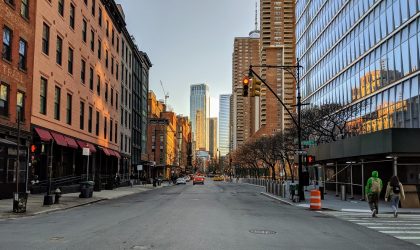Nosy Neighbor: Just how many lanes are on Greenwich?
A. writes: “Is Greenwich Street a single lane street, or more? There are no lines, so it seems like it should be a single lane road, but I’ve seen two lanes form, and sometimes a creative third lane, in addition to parked cars.”
This is my favorite nosy neighbor to date! A real urban mystery! And the DOT solved it with this: “The cobblestone portion of Greenwich Street is one lane and other portions that have asphalt are two lanes.” So that puts the dividing line between one lane and two at Hubert, meaning you can pass the trolling taxis once you hit the Citibank building.
Who knew? So keep to your lanes, folks.




















A better question might be why is the cobblestone roadwork on Greenwich (and Harrison, etc.) that was redone fairly recently not holding up, and in worse shape than streets that have not been repaved since the 1930’s (for example stretches of Vestry)?
It also used to be easier to get your typewriter, horseshoes, film cameras, and rotary telephones repaired. This is a 19th century technology and once it gets ripped up for utilities work or misguided restoration, it loses its original integrity.
Per Historic Districts Council in 2017: “Still, well into the 20th century, Belgian blocks persisted as a pavement that defined the visual, material, and functional texture of the streetscape in many parts of New York City. In 1949, for example, Manhattan still had 140 miles of granite block streets. Today, citywide, perhaps 15 miles remain.”
They set new Belgian blocks in sand it seems. When that shifts from under them the whole integrity is shot. Maybe it’s easier to dig them up for road works but they’re awful. Should have left all the messed up ones and holes in that intersection from the tunnel and slow up all the NJ drivers headed to WSH.
The sand-setting is also for “sustainability,” per the NYCDOT Street Design Manual, “3.1.10 Granite Block”
“Should be sand-set for easier installation and greater permeability wherever impermeable installation generates stormwater runoff […]
“Can be mortar-set for stronger structural properties”
would be better if paving was changed to asphalt or cement.
they are not bringing back Horse and Wagon.
safer if people, cars and trucks have better traction.
All of Greenwich st in TriBeCa should be cobble stone to avoid speedy cars and safety for all! Not to mention with keeping the aesthetic feel of the district.
Even more of a question is why there is no yellow dividing line on Harrison Street between West and Greenwich Streets where that section is a 2-way street!
The original cobblestone streets were in great condition until they ripped them up in the early 2000’s. Years later with the initiative to re-cobblestone the streets they were a mess from day one. Laying cobblestone is an art and the city obviously did not hire artisans to replace the beautiful stones they had years earlier recklessly ripped up. You could bike easily on the old cobblestones, walk in heels, drive smoothly. You cannot do any of the aforementioned since the day those stones were laid. They should have stuck with the pavement.
Great answer, thanks
Remember Hurricane Sandy? Alot of flooding over on the westside downtown put the nail in the coffin for those redone cobblestones in sand…plus they did a really shoddy job